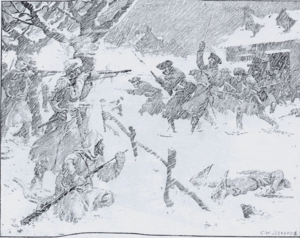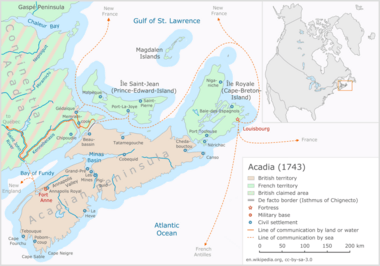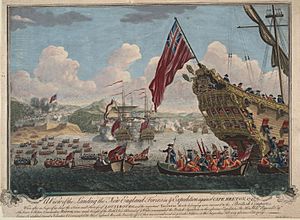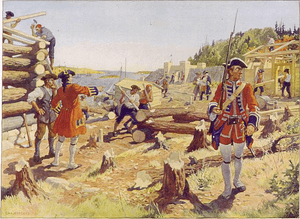King George's War facts for kids
Quick facts for kids King George's War |
|||||||
|---|---|---|---|---|---|---|---|
| Part of the War of Austrian Succession and the American Indian Wars | |||||||
 French and Mi'kmaq raid on Grand Pré, February 1747 |
|||||||
|
|||||||
| Belligerents | |||||||
|
|
Iroquois Confederacy | ||||||
| Commanders and leaders | |||||||
| Father Jean-Louis Le Loutre Father Pierre Maillard |
|||||||
King George's War was a conflict in North America from 1744 to 1748. It was part of a larger European war called the War of the Austrian Succession. This war was the third of four major conflicts between the British and French in North America, often called the French and Indian Wars.
The fighting mainly happened in British areas like New York, Massachusetts Bay (which included Maine), New Hampshire (which included Vermont), and Nova Scotia. A key event was when British colonists from Massachusetts captured the French fortress of Louisbourg in 1745. The war ended with the Treaty of Aix-la-Chapelle in 1748. This treaty returned Louisbourg to France and didn't solve the land disagreements between the two sides.
Why the War Started
The main reason for King George's War was a bigger conflict in Europe. This was the War of the Austrian Succession, which began in 1740. It was a fight over who should rule Austria.
Before that, in 1739, a smaller war called the War of Jenkins' Ear started between Spain and Great Britain. This war was mostly in the Caribbean Sea and between Spanish Florida and the British Province of Georgia.
Britain joined the European war in 1742, siding with Austria against France and Prussia. However, Britain and France did not officially start fighting each other until March 1744. Massachusetts declared war on French Quebec in June of that year.
How the War Happened

News of the war reached the French Fortress of Louisbourg first, on May 3, 1744. French forces quickly began attacking. They were worried about their supply routes to Quebec. So, they raided the British fishing port of Canso on May 23.
Next, the French planned an attack on Annapolis Royal, the capital of Nova Scotia. But the French forces were slow to leave Louisbourg. Their Mi'kmaq and Maliseet allies, along with Father Jean-Louis Le Loutre, decided to attack on their own in early July.
Annapolis had already heard about the war. British soldiers were somewhat ready when the First Nations warriors began attacking Fort Anne. Since they didn't have heavy weapons, the Mi'kmaq and Maliseet left after a few days. In mid-August, a larger French force arrived at Fort Anne. But they also could not attack the fort effectively. The fort had received supplies and more soldiers from Massachusetts.
In 1745, British colonial forces captured Fortress Louisbourg. This happened after a six-week siege. In response, the Wabanaki Confederacy in Acadia launched attacks against British settlements in northeast Maine.

France then sent a large group of ships and soldiers to get Louisbourg back in 1746. But storms and sickness hit the expedition hard. Its commander, the Duc d'Anville, died. The remaining soldiers returned to France without reaching Louisbourg.
The war also involved fighting along the borders between the northern British colonies and New France. Both sides had Native American allies. Villages on the edges of the settlements were often raided. People were taken captive for ransom or sometimes adopted by Native American tribes.
Because of these frequent raids, Governor William Shirley ordered new forts to be built. These forts stretched west to the border with New York.
On November 28, 1745, French forces and their Native American allies attacked and destroyed the village of Saratoga, New York. More than a hundred people were killed or captured. After this, the British left their settlements in New York north of Albany.
In July 1746, a group of Iroquois and colonial soldiers gathered in northern New York. They planned to attack the French. But the British soldiers they expected never arrived, so the attack was called off.
A large French and First Nations force (over 1,000 men) had planned to raid the upper Hudson River valley in 1746. Instead, they raided the Hoosac River valley. This included an attack on Fort Massachusetts. This attack was in revenge for a Native American leader being killed earlier. Other raids included a 1747 French and Mi'kmaq raid on Grand Pré, Nova Scotia. In 1748, Native American allies of the French raided Schenectady, New York.
What Happened After the War

The war was very costly, especially for the northern British colonies. For example, it's thought that 8% of all adult men in Massachusetts died in 1745–46.
The Treaty of Aix-la-Chapelle ended the war. Louisbourg was given back to France. In return, the city of Madras in India, which the French had captured from the British, was returned. This decision made people in New England very angry. They had spent a lot of money and sent many soldiers to capture Louisbourg.
The British government later paid Massachusetts £180,000 for its efforts. Massachusetts used this money to fix its currency problems.
The peace treaty returned all colonial borders to where they were before the war. But it did not end the bad feelings between France, Britain, and their colonies. It also didn't solve any land disagreements. Tensions remained high in both North America and Europe. These tensions led to another war in 1754, known as the French and Indian War in North America. This war then spread to Europe two years later as the Seven Years' War. In Acadia and Nova Scotia, fighting continued between 1749 and 1755 in Father Le Loutre's War.
See also
 In Spanish: Guerra del rey Jorge para niños
In Spanish: Guerra del rey Jorge para niños

